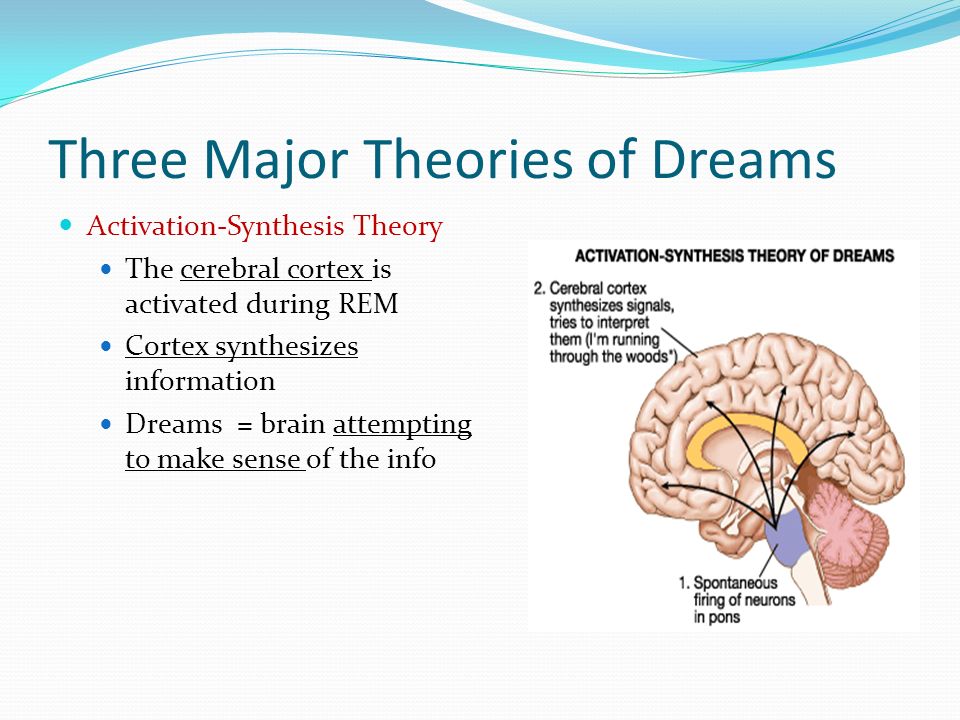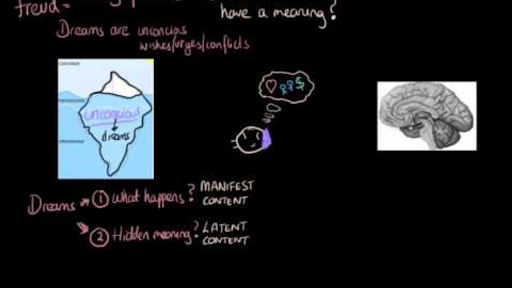Which Best Fits the Activation-synthesis Theory of Dreaming
Activation-synthesis theory is a neurobiological explanation for the genesis of dreams first proposed in the late 1970s by J. Which theory of dreaming does that support.

Dream Theories Ppt Video Online Download
The function of our heart to pump blood into our body.

. The theory claims that during REM sleep the brains neurons are firing in the lower brain centers which send information to the cortex or the part of the brain that makes sense of inputs during normal consciousness. Latent content-way dream is interpreted. According to their theory dreams.
Question 42 4 pts Which best fits the continual-activation theory of dreaming. Online tutorial on theories of dreaming. Figure 1There are many theories about why we dream.
Explanationthe theory that dreams result from the brains attempt to make sense of random of random neural signals th jacksonnatalia12 jacksonnatalia12 10232020 Health High School answered The activation-synthesis theory says that. You just awoke from a startling dream in which you were very frightened but could not move. As suggested by its name its made up of two parts.
Psychology Home KNOWLEDGE UNITS PSYCHOLOGY SKILLS UNITS. Activation-Synthesis Model Of Dreaming. The function of sleep is to process encode and transfer data from short-term memory to long-term memory.
The activation synthesis hypothesis views dream content as random side effects of brain activity with little or no meaning. The activation-synthesis model of dreaming says that dreams are a meaningless by-product or epiphenomenon of sleep. A model of dreaming proposed by Hobson and McCarley where the brain is active but no sensory information is coming into it.
This theory explains why dreams are usually forgotten immediately afterwards. Allan Hobson and Robert McCarley. While sleeping and dreaming have yet to be definitively defined they are indicative of the endless possibilities behind the mystery of the human brain which is pretty cool.
The theory essentially is quite basic and simple. According to the activation-synthesis hypothesis a dream represents the brains effort to make sense of sparse and distorted information. Allan Hobson and Robert McCarley first proposed their theory in 1977 suggesting that dreaming results from the brains attempt to make sense of neural activity that takes place during sleep.
The function of the brain to trigger the heart to pump blood. That night he dreamt about getting in a fight with him. Asked Feb 12 2021 in Psychology by VietnameseGirl.
And the synthesis refers to the interpretation of these random signals into spontaneous thoughts by the cerebral cortex. The activation-synthesis theory claims that dreams are meaningless interpretations of random firings of the brain. Sleepers are not passive participants in their sleep cycle but active participants who undergo physiological changes while they slumber.
The function of sleep is to process encode and transfer data from STM to LTM. Under this theory dreams are an attempt by the brain to make sense of neural activity which occurs while people sleep. Answerif im correct your answer is B.
The Activation Synthesis Dream Theory is an attempt to explain why it is that humans dream. If approached on the street by a stranger and asked to make a guess. Dreaming serves to discharge emotional arousals that havent been expressed during the day.
They are merely electrical brain impulses that pull random thoughts and imagery from our memories. What are the 3 major dream theories. Up to 24 cash back Activation Synthesis Theory of Dreaming.
Which best fits the activation-synthesis theory of dreaming. Powered by Create your own unique website with customizable templates. It is a question that scientists philosophers and clergy have attempted to solve for thousands of years.
Dreaming-Activation Synthesis theory of dreaming. Which best fits the continual-activation theory of dreaming. The function of sleep is to process encode and transfer data from short-term memory to long-term memory.
Activation refers to the random firing of neurons from the brain stem. The expectation-fulfillment theory says that we use up emotional energy during the night. Several facts support this theory specifically that dreaming is associated with the amygdala which is activated by real dangers.
The brain puts the information it has together to make sense of it and this is the dream. Up to 24 cash back The activation-synthesis theory is a neurobiological explanation of why we dream. The activation-synthesis hypothesis predicts that dreams arise from brain activity originating from bursts of excitatory messages arising from the brainstem.
Please select the best answer from the. The theory posits that humans construct dream stories after. Dreams are part.
The activation-synthesis model suggests that our brains cause dreams by means of neural activity during REM cycles. However people used to believe sleeping and dreaming was a. Dreaming serves to discharge emotional arousals that havent been expressed during the day.
Manifest content-way dream is remembered. One prominent neurobiological theory of dreaming is the activation-synthesis theory which states that dreams dont actually mean anything. Other resources videos.
The threat-simulation theory sees dreaming as an evolutionary practice ground for dealing with threats. Only importance is the emotion of the dream.

Theories Of Dreaming Freud S Wish Fulfillment Theory Dreams Are An Attempt To Satisfy Sexual And Aggressive Impulses That We Cannot Satisfy When We Are Ppt Download

Neural Activation Theory Of Dreaming Mod 5 Dual Processing Sleep Dreams Dream Theory Information Processing Sleep Dream

Dream Theories Freud Activation Synthesis Hypothesis Video Khan Academy

Dream Theories Freud Activation Synthesis Hypothesis Video Khan Academy
Comments
Post a Comment